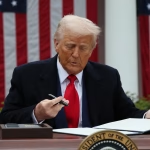Dollar Stumbles in 2025—but Its Global Grip Remains Firm
It’s been a brutal six months for the greenback. The U.S. dollar just posted its worst first-half performance in over 50 years, falling 10% against a basket of major global currencies. For the world’s reserve currency, that kind of slide doesn’t go unnoticed.
Yet despite the slump, this may be more of a recalibration than a collapse. Investors may be moving cautiously, but the dollar’s grip on the global financial system isn’t loosening just yet.
What’s Weighing on the Dollar?
The dramatic slide this spring wasn’t caused by a single event—it was a convergence of trends. April’s market turmoil made investors jittery, prompting a shift toward diversification. Major institutions like European asset managers and Asian pension funds, long heavy on U.S. assets, began seeking shelter from potential losses by hedging against the dollar.
Add to that the expectation of slower U.S. growth, and the picture becomes clearer. Oxford Economics’ Adam Slater predicts the dollar could remain under pressure through 2027 as the gap between U.S. economic performance and the rest of the world narrows.
A cooling U.S. economy could lead the Federal Reserve to cut interest rates, making U.S. bonds less appealing. “The disappearance of hefty growth and stock market differentials will weaken the case for investing in the U.S.,” Slater said. Less capital flowing into the U.S. usually means less demand for the dollar.
Meanwhile, political unpredictability isn’t helping. With tariff threats, attacks on the Fed, and rising deficits, investors are finding it harder to take a long-term view on U.S. policy. As market strategist Crit Thomas put it: “Trust arrives on foot and it leaves on horseback.”
Is the Dollar Losing Its Crown?
Not quite. While some analysts have raised the alarm about the dollar’s global role, most experts agree that its throne is still secure.
“There’s no alternative,” said Ed Al-Hussainy, a global strategist at Columbia Threadneedle Investments. “There’s no behavior change this year that justifies the idea that the dollar is losing its reserve status.”
U.S. assets still offer things global investors value: transparency, liquidity, and a legal framework they trust. That matters more than ever in a world where economic and political uncertainty is spreading.
The size of the U.S. bond market is also a key reason the dollar still dominates. With trillions in circulation, it’s the deepest, most liquid bond market in the world—far eclipsing China, Japan, or even Europe.
Central Banks Are Diversifying, Not Abandoning the Dollar
It’s true that central banks are beginning to spread their bets. A recent global survey showed more interest in the euro, China’s renminbi, and even gold. But that doesn’t mean they’re ditching the dollar.
The Official Monetary and Financial Institutions Forum, which conducted the survey, said it best: this is a case of diversification, not de-dollarisation. Over 80% of central banks still believe the dollar provides unmatched safety and liquidity. And most expect it to remain the world’s go-to currency for the next decade or more.
🔍 Curious how celebrity estates are managed? Don’t miss our deep dive into Paris Jackson’s $150M net worth and complex inheritance from her father, Michael Jackson.
People Also Ask
Why did the U.S. dollar fall so much in early 2025?
The dollar dropped due to a mix of slower U.S. growth expectations, market volatility in April, and global investors hedging against further weakness. It’s not a loss of faith—just a strategic pivot in uncertain times.
Could another currency replace the U.S. dollar soon?
It’s unlikely. Despite its recent dip, the dollar remains the most trusted and widely used currency in the world. Alternatives like the euro or renminbi lack the depth, liquidity, and global reach of the dollar.
What role does the Federal Reserve play in the dollar’s strength?
The Fed influences the dollar through interest rate decisions. If rates fall, U.S. bonds become less attractive, reducing demand for the dollar. Future rate cuts could add pressure, but they’re part of a broader economic balancing act.
Should investors worry about the dollar’s future?
No need to panic. Short-term volatility is normal, and most experts agree that the dollar’s foundational strength—transparency, liquidity, and scale—remains solid. Diversification is smart, but the dollar still plays a central role in global finance.
Related Article: Markets Find Cautious Optimism as Tariff Deadline Gets a Last-Minute Extension
A Dip, Not a Downfall
While the dollar’s rough first half has understandably raised eyebrows, this isn’t the beginning of the end. It’s a reminder that no asset—even the world’s dominant currency—is immune to market cycles and shifting sentiment.
The silver lining? Global diversification is healthy. It reflects a maturing financial landscape and gives investors more options. But the dollar’s unmatched liquidity, reliability, and institutional backing mean it's not going anywhere anytime soon.
It may be down—but it's far from out.













